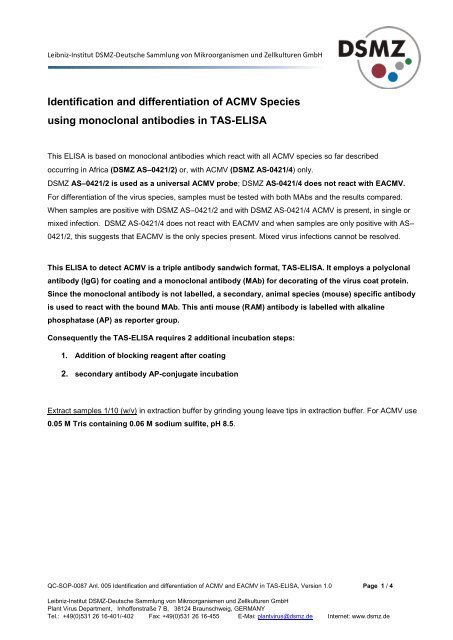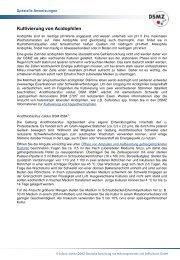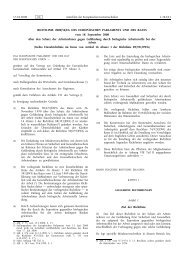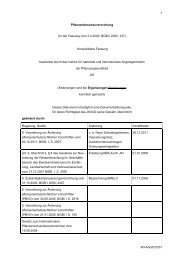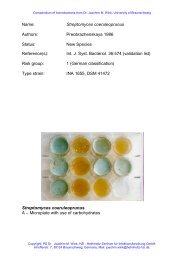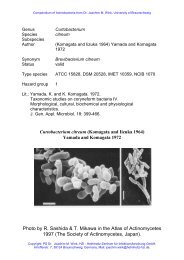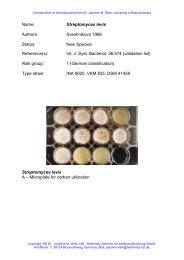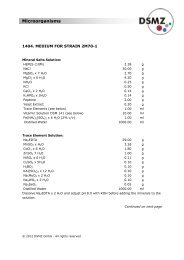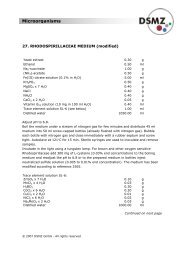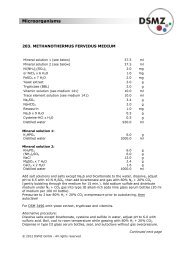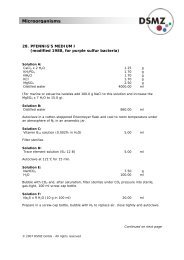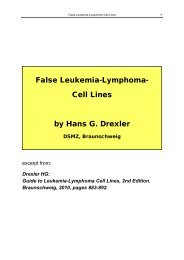Leibniz-Institut DSMZ GmbH ⢠InhoffenstraÃe 7 B ⢠38124 ...
Leibniz-Institut DSMZ GmbH ⢠InhoffenstraÃe 7 B ⢠38124 ...
Leibniz-Institut DSMZ GmbH ⢠InhoffenstraÃe 7 B ⢠38124 ...
You also want an ePaper? Increase the reach of your titles
YUMPU automatically turns print PDFs into web optimized ePapers that Google loves.
<strong>Leibniz</strong>-<strong>Institut</strong> <strong>DSMZ</strong>-Deutsche Sammlung von Mikroorganismen und Zellkulturen <strong>GmbH</strong><br />
Identification and differentiation of ACMV Species<br />
using monoclonal antibodies in TAS-ELISA<br />
This ELISA is based on monoclonal antibodies which react with all ACMV species so far described<br />
occurring in Africa (<strong>DSMZ</strong> AS–0421/2) or, with ACMV (<strong>DSMZ</strong> AS-0421/4) only.<br />
<strong>DSMZ</strong> AS–0421/2 is used as a universal ACMV probe; <strong>DSMZ</strong> AS-0421/4 does not react with EACMV.<br />
For differentiation of the virus species, samples must be tested with both MAbs and the results compared.<br />
When samples are positive with <strong>DSMZ</strong> AS–0421/2 and with <strong>DSMZ</strong> AS-0421/4 ACMV is present, in single or<br />
mixed infection. <strong>DSMZ</strong> AS-0421/4 does not react with EACMV and when samples are only positive with AS–<br />
0421/2, this suggests that EACMV is the only species present. Mixed virus infections cannot be resolved.<br />
This ELISA to detect ACMV is a triple antibody sandwich format, TAS-ELISA. It employs a polyclonal<br />
antibody (IgG) for coating and a monoclonal antibody (MAb) for decorating of the virus coat protein.<br />
Since the monoclonal antibody is not labelled, a secondary, animal species (mouse) specific antibody<br />
is used to react with the bound MAb. This anti mouse (RAM) antibody is labelled with alkaline<br />
phosphatase (AP) as reporter group.<br />
Consequently the TAS-ELISA requires 2 additional incubation steps:<br />
1. Addition of blocking reagent after coating<br />
2. secondary antibody AP-conjugate incubation<br />
Extract samples 1/10 (w/v) in extraction buffer by grinding young leave tips in extraction buffer. For ACMV use<br />
0.05 M Tris containing 0.06 M sodium sulfite, pH 8.5.<br />
QC-SOP-0087 Anl. 005 Identification and differentiation of ACMV and EACMV in TAS-ELISA, Version 1.0 Page 1 / 4<br />
<strong>Leibniz</strong>-<strong>Institut</strong> <strong>DSMZ</strong>-Deutsche Sammlung von Mikroorganismen und Zellkulturen <strong>GmbH</strong><br />
Plant Virus Department, Inhoffenstraße 7 B, <strong>38124</strong> Braunschweig, GERMANY<br />
Tel.: +49(0)531 26 16-401/-402 Fax: +49(0)531 26 16-455 E-Mai: plantvirus@dsmz.de Internet: www.dsmz.de
<strong>Leibniz</strong>-<strong>Institut</strong> <strong>DSMZ</strong>-Deutsche Sammlung von Mikroorganismen und Zellkulturen <strong>GmbH</strong><br />
TAS- ELISA , ACMV<br />
Please spin down all the liquid by a short centrifugation (approx. 3000rpm for a few seconds)<br />
before opening the tubes containing coating antibody (IgG), MAb and RAM-AP- Conjugate .<br />
1. Dilute purified IgG (<strong>DSMZ</strong> AS-0421) in coating buffer (recommended dilution see delivery note and tube).<br />
e.g. for 100 tests: 20 µl in 20 ml buffer at a recommended dilution of 1:1000; 40 µl in 20 ml buffer at a<br />
recommended dilution of 1:500. Or at equal ratios for other volumes.<br />
Add 200 µl to each well of a microtitre plate.<br />
2. Incubate at 37 °C for 2-4 h.<br />
3. Wash plate with PBS-Tween using wash bottle, soak for a few minutes and repeat washing two times. Blot plates<br />
by tapping upside down on tissue paper.<br />
4. Add 200 µl of 2% skim milk in PBS-Tween to each well (blocking). 30 min at 37°C<br />
5. Remove blocking solution and tap dry.<br />
6. Add 200 µl aliquots of the test sample (extracted in sample extraction buffer) to duplicate wells.<br />
7. Incubate overnight at 4 °C.<br />
8. Wash three times as in step 3.<br />
9. Add 200 µl of the MAb (AS-0421/2 or AS-0421/4) in appropriate dilution (recommended dilution see<br />
delivery note and tube label) in conjugate buffer to each well.<br />
10. Incubate at 37 °C for 2-4 h.<br />
11. Wash three times as in step 3.<br />
12. Add 200 µl of RAM-AP in appropriate conjugate buffer to each well.<br />
13. Incubate at 37 °C for 1-2 hours.<br />
14. Wash three times as in step 3.<br />
15. Add 200 µl aliquots of freshly prepared substrate (10 mg p-nitrophenyl phosphate [Sigma, Fluka] dissolved in<br />
10 ml of substrate buffer) to each well. Incubate at room temperature for 30-60 min, or as long as necessary to<br />
obtain clear reactions<br />
QC-SOP-0087 Anl. 005 Identification and differentiation of ACMV and EACMV in TAS-ELISA, Version 1.0 Page 2 / 4<br />
<strong>Leibniz</strong>-<strong>Institut</strong> <strong>DSMZ</strong>-Deutsche Sammlung von Mikroorganismen und Zellkulturen <strong>GmbH</strong><br />
Plant Virus Department, Inhoffenstraße 7 B, <strong>38124</strong> Braunschweig, GERMANY<br />
Tel.: +49(0)531 26 16-401/-402 Fax: +49(0)531 26 16-455 E-Mai: plantvirus@dsmz.de Internet: www.dsmz.de
<strong>Leibniz</strong>-<strong>Institut</strong> <strong>DSMZ</strong>-Deutsche Sammlung von Mikroorganismen und Zellkulturen <strong>GmbH</strong><br />
17. Assess results by:<br />
Reference<br />
a) Visual observation<br />
b) Spectrophotometric measurement of absorbance at 405 nm<br />
Clark, M. F. and A. N. Adams. 1977. Characteristics of the microplate method of enzyme-linked immunosorbent assay for<br />
the detection of plant viruses. Journal of General Virology 34: 475-483.<br />
Buffers used in ELISA<br />
1. Coating buffer (pH 9.6)<br />
1.59 g sodium carbonate (Na2CO3)<br />
2.93 g sodium bicarbonate (NaHCO3)<br />
0.20 g sodium azide (NaN3)<br />
Dissolve in 900 ml H2O, adjust pH to 9.6 with HCl and make up to 1 l.<br />
2. PBS (pH 7.4) phosphate buffer saline<br />
3. PBS-Tween (PBST)<br />
8.0 g sodium chloride (NaCl)<br />
0.2 g monobasic potassium phosphate (KH2PO4)<br />
1.15 g dibasic sodium phosphate (Na2HPO4)<br />
0.2 g potassium chloride (KCl)<br />
0.2 g sodium azide (NaN3)<br />
Dissolve in 900 ml H2O, adjust pH to 7.4 with NaOH or HCl and make up to 1 l.<br />
PBS + 0.5 ml Tween 20 per liter<br />
4. Sample extraction buffer (pH 8.5)<br />
5. Conjugate buffer<br />
6. Substrate buffer<br />
For ACMV use 0.05 M Tris containing 0.06 M sodium sulfite, pH 8.5<br />
PBST + 2% PVP (Serva PVP-15 polyvinyl pyrrolidone) + 0.2% egg albumin (Sigma A-5253)<br />
97 ml diethanolamine<br />
600 ml H2O<br />
0.2 g sodium azide (NaN3)<br />
Adjust to pH 9.8 with HCl and make up to 1 liter with H2O<br />
Buffers can be stored at 4 °C for at least 2 months. Warm to room temperature before use.<br />
QC-SOP-0087 Anl. 005 Identification and differentiation of ACMV and EACMV in TAS-ELISA, Version 1.0 Page 3 / 4<br />
<strong>Leibniz</strong>-<strong>Institut</strong> <strong>DSMZ</strong>-Deutsche Sammlung von Mikroorganismen und Zellkulturen <strong>GmbH</strong><br />
Plant Virus Department, Inhoffenstraße 7 B, <strong>38124</strong> Braunschweig, GERMANY<br />
Tel.: +49(0)531 26 16-401/-402 Fax: +49(0)531 26 16-455 E-Mai: plantvirus@dsmz.de Internet: www.dsmz.de
<strong>Leibniz</strong>-<strong>Institut</strong> <strong>DSMZ</strong>-Deutsche Sammlung von Mikroorganismen und Zellkulturen <strong>GmbH</strong><br />
ELISA Troubleshooting<br />
1. No color development<br />
a) Did you omit any steps?<br />
b) Did you use correct buffer for each step?<br />
c) Is your enzyme OK? Serum OK?<br />
d) Is your positive control homologous to antiserum (IgG)?<br />
Recommendations - Do a titration plate. Use reliable positive control in each plate. Pretest enzyme<br />
conjugate on substrate. Check purified IgG for antigen-specific IgG.<br />
2. Nonspecific color development<br />
a) If in edge wells only:<br />
- Make sure the humidity in the incubator is sufficiently high.<br />
- If this does not help, don't use edge or border wells, fill with buffer only.<br />
b) If in whole plate:<br />
- incomplete washing<br />
- old substrate<br />
- error in loading sequence<br />
- conjugate still contains glutaraldehyde: dialyse again<br />
Recommendations - Use reliable negative control in each plate. Absorb antiserum against healthy plant extract. Use<br />
fresh substrate and check for spontaneous color change. Cover plates. Check pH of the buffers used.<br />
c) Some wells with inconsistent or unexpected reactions<br />
- incomplete washing<br />
- error in loading test antigens<br />
- spillage between wells<br />
Recommendations - Use extra wash step, handle plates carefully with lids on, use predetermined loading<br />
pattern before loading. Blot top of plate after rinsing.<br />
3. Color development very rapid; some color in healthy samples<br />
a) Enzyme conjugate concentration too high<br />
b) Substrate concentration too high<br />
Recommendations - Use enzyme conjugate and substrate concentrations that will give OD405 nm of about 1.0<br />
in 30 to 60 min with good antigen source.<br />
QC-SOP-0087 Anl. 005 Identification and differentiation of ACMV and EACMV in TAS-ELISA, Version 1.0 Page 4 / 4<br />
<strong>Leibniz</strong>-<strong>Institut</strong> <strong>DSMZ</strong>-Deutsche Sammlung von Mikroorganismen und Zellkulturen <strong>GmbH</strong><br />
Plant Virus Department, Inhoffenstraße 7 B, <strong>38124</strong> Braunschweig, GERMANY<br />
Tel.: +49(0)531 26 16-401/-402 Fax: +49(0)531 26 16-455 E-Mai: plantvirus@dsmz.de Internet: www.dsmz.de


